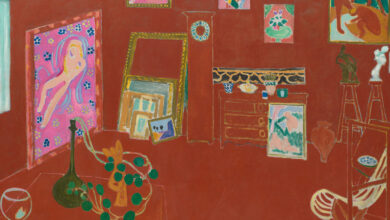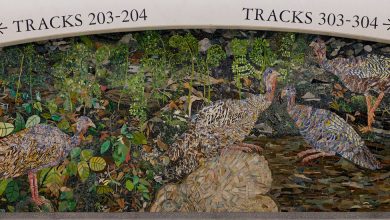The Twisting Trail to the Tonys: ‘Can You Believe That We’re Here?’

Deirdre O’Connell, a veteran stage actress who notched her first Tony nomination this year by mesmerizingly lip-syncing 75 minutes of harrowing testimony from a kidnapping victim, ran into Michael R. Jackson, the Pulitzer-winning musical writer, at an awards event just down the hall from a silvery 9-foot-tall Tony medallion.
O’Connell, who starred in “Dana H.,” told Jackson how happy she was for him, and that “he’s changing the world, and I’m really glad.” The admiration, it turned, out, was mutual: Jackson, whose boundary-busting show “A Strange Loop” is nominated for best musical, liked “Dana H.” so much he went twice. “I saw opening night and I screamed, ‘Finally! Something good!’” Jackson said. “And then I came back to see it again.”
At the end of a bumpy Broadway season that started late and was repeatedly disrupted by the coronavirus pandemic, the once-ordinary rituals of Tonys time have taken on a new significance this spring, as a beleaguered theater industry grasps for reassurance that some kind of new normal is just around the corner. Sure, the gatherings are only for the vaccinated, tested and masked (except when being photographed), but still, it’s a start.
So on a Thursday in mid-May, there was Charlotte St. Martin, president of the Broadway League, comparing footwear with Kenita R. Miller, a nominee from “For Colored Girls Who Have Considered Suicide/When the Rainbow Is Enuf,” at the first Meet the Nominees press event since 2019. (St. Martin, who spent all day gripping and grinning in front of that oversized medallion, wore beige Manolo Blahnik slingback pumps; a very pregnant Miller, who is expecting to give birth this month, went with cream-and-white Asics sneakers.)




Meet the nominees: Clockwise from top left, Sutton Foster, left, and Joaquina Kalukango; Camille A. Brown, left, and Kenita R. Miller; Mary-Louise Parker, left, and Kara Young; and Jesse Tyler Ferguson, from left, Jesse Williams and Michael Oberholtzer.Credit…Photographs by Sara Krulwich
Kara Young, a nominee who made her Broadway debut in the formerly-incarcerated-people-running-a-sandwich-shop comedy “Clyde’s,” bowed low when she happened upon Mary-Louise Parker, the ace actress starring, for a second time in 25 years, as a woman recalling sexual abuse by her uncle in the play “How I Learned to Drive.” And Uzo Aduba, also nominated for “Clyde’s,” enveloped Jesse Williams, nominated for playing a gay baseball player in “Take Me Out,” in a giddy hug as the two crossed paths while trying to navigate a crowded corridor of press alcoves.
“Can you believe that we’re here, that we’re doing this, that our community invited us to sit at this table?” Aduba said. “This is my first time ever being part of this experience, and there’s this feeling of ‘wow.’”
Just getting to this point was a wow.
This first post-shutdown season was dogged by the tenacious coronavirus, which repeatedly demonstrated that no matter how much the industry and the city were ready to move on, Covid-19 wasn’t done yet. In December, the Omicron wave forced as many as half of all Broadway shows to close some nights. By January, there were just 19 shows running in Broadway’s 41 theaters. And come April, as the number of shows nearly doubled to meet the Tony eligibility deadline, another uptick in cases coursed through Manhattan, infecting Sarah Jessica Parker, Daniel Craig, Laurence Fishburne and many others performing on Broadway.
Covid was not the season’s only challenge. There was a racial reckoning, prompted by the societal unrest of that first pandemic summer; the death of Stephen Sondheim, the revered composer and lyricist; the disappearance of Scott Rudin, the once-dominant producer accused of bullying behavior; and the diminution of tourism, long an economic lifeblood for Broadway.

Early signs of a comeback: Workers at the St. James Theater prepared for a return engagement of “Springsteen on Broadway,” which kicked off Broadway’s staggered reopening last June.Credit…Sara Krulwich/The New York Times
Nonetheless, 34 plays and musicals managed to open this season, and now 29 of those have scored at least one Tony nomination. The Tony Awards ceremony, on June 12, will take place just about a year after Bruce Springsteen stepped onstage at the St. James Theater, kicking off Broadway’s staggered reopening. Here’s a look at some of the ways this season was one for the books.
A Season of Opportunity for Black Writers
Ninety minutes before curtain one night in late April, the company of “A Strange Loop” gathered inside an empty Lyceum Theater and formed a circle onstage. It was the long-awaited opening night for the new musical, and, even though Covid had forced the show to scrap a planned party, the production was determined to make the night memorable.
The lead producer bestowed plush robes — one zebra-patterned, one tiger, one cheetah — on the three members of the cast with Broadway experience. Then, in a homage to an Actors’ Equity ritual for shows with choruses, those Broadway veterans ran around the circle three times, allowing each member of the company to touch their robes, and seeking a blessing for a long and successful run.
“This has been a long time coming, in so many ways,” Jackson, who was 23 when he started writing the show and is now 41, said in an emotional curtain speech several hours later, after a prolonged standing ovation from a star-studded crowd that included Queen Latifah and Bryan Cranston.
“A Strange Loop,” billing itself as a “big, Black & queer-ass American musical,” was among the bounty of shows by Black writers to open on Broadway this season — almost certainly the most in history, reflecting what appeared to be a new openness to such work on the part of theater owners and producers facing pressure, and criticism, following the unrest over racial injustice that roiled America in the summer of 2020.
The season brought five new plays by Black writers — “Chicken & Biscuits,” “Clyde’s,” “Pass Over,” “Skeleton Crew” and “Thoughts of a Colored Man” — as well as revivals of “For Colored Girls,” “Lackawanna Blues” and “Trouble in Mind,” and a reprise run of “Slave Play.” Also, the three new musicals that received the most Tony nominations — “A Strange Loop,” “MJ” and “Paradise Square” — all had Black book writers.
How did they fare? Artistically, many were well received — the revivals were generally praised by critics, as were some of the new plays.
Financially, however, it was a different picture. None of the plays, as often happens with plays, were a financial success. In the fall both “Chicken & Biscuits” and “Thoughts of a Colored Man” cut their runs short. And an acclaimed revival of “For Colored Girls” has struggled to attract audiences and announced an early closing date, though its grosses ticked up last week bolstered by seven Tony nominations and a pay-it-forward social media campaign to get tickets in the hands of people who might otherwise not be able to afford them.
But the high number of shows with Black authors, as well as the intensified focus on the underrepresentation of people of color on Broadway creative teams, led to far more opportunities for Black theater artists, onstage and off. And that, in turn, meant more opportunities for Black actors and designers to compete during awards season: the Tony nominations featured an unusually broad array of Black nominees.
Will Black writers continue to be produced in such abundance? Next season is still taking shape, but at this stage it appears that the there will be more work by Black writers than there had been prepandemic, but not as much as this season, and with more of an emphasis on established writers than emerging artists. Thus far, only a revival of August Wilson’s “The Piano Lesson” appears certain, but others are circling.
Also noteworthy: After a season in which the diversity discussion focused on work by Black writers, next season is expected to have at least two musicals whose creative teams include Asian or Asian American writers, “KPOP” and “Come Fall in Love — The DDLJ Musical.”
Black artists say they’ll be watching to see whether the industry’s commitment to greater diversity continues. “I’m feeling hopeful,” Aduba said. “But I’m sleeping with one eye open.”
Pandemic Shuffle: Start. Stop. Start Again.
On the last Friday of April, the propmasters for “Girl From the North Country” gathered once again, backstage at the Belasco, to ready the fixings for a Thanksgiving dinner. There were potatoes to mash; stuffing to prepare; bread to slice; sauce to stir; and turkey to arrange — with just an hour to go before the first performance. Again.
“Happy opening 3.1,” Olivia Wells, a props assistant, said to the actor Robert Joy as he walked past the narrow food prep area just behind the stage.
One of the exceptional elements of this theater season has been its start-and-stop nature. And few shows have had as many reboots as “Girl From the North Country,” a musical about the denizens of a Depression-era boardinghouse in Duluth, Minn., set to the songs of that city’s famous son, Bob Dylan. The show opened on March 5, 2020, just a week before theaters shut down for the pandemic; restarted on Oct. 13, 2021; took a three-month hiatus when Omicron hit; and then started for a third time on April 29.
There were others in similar positions — “Mrs. Doubtfire,” for example, as well as “To Kill a Mockingbird” — but “Girl From the North Country” is the only show that opened in 2020 and is nominated for Tony Awards in 2022, reflecting a singular complication: it opened so few days before the shutdown that not enough Tony voters got to see it, so it was moved into a different season for eligibility consideration. The show never loaded out of the Belasco — its set has been there for 27 months, even though it has been performed only for four.
On that late April day, an hour before curtain, the cast, with a handful of newcomers, once again gathered onstage. “We have our theater back, and we have each other,” said Conor McPherson, a double Tony nominee for directing the musical and writing its book. “The last few years, the journey that we’ve been on, while at times frightening and filled with disappointment and anxiety, has brought us all together, and kept us together.”
Others offered bespoke congratulations. “Happy re-re-re-opening,” said a lead producer, Tristan Baker.
The actors segued into fight call — a preshow stage combat safety check: Austin Scott rehearsed slugging Colin Bates, who joined the cast last fall, and then Todd Almond practiced choking Craig Bierko, who was new to the cast this go-round. “Good, good. Very nice, very nice,” said a satisfied production stage manager, Jeff Brancato. “It’s like the first time, but the millionth time.”
A remarkably high percentage of shows planning to open in 2020 returned to try again after the shutdown ended, in many cases because of some combination of insurance money and federal aid. The best example is “Hangmen,” the dark British comedy set in a bar run by a onetime executioner; the lead producer, Robert Fox, announced in 2020 that the show would not return, and the set was ripped out and torn up, but then in 2022, with new money and new resolve, he reversed course, and now the show is a Tony nominee (as is its rebuilt set).
The most on-brand resurrection, of course, is that of “Beetlejuice,” the 2019 show that begs for back-from-the-dead wordplay given its netherworldly plot. The musical was at first doing so poorly that it was told it needed to vacate the Winter Garden Theater by the Shubert Organization, which had promised the building to Scott Rudin for “The Music Man.” Then, fueled by TikTok-amplified fan love, the show’s financial fortunes improved, but too late for it to stay in place. Before it moved out, the pandemic hit. In the transition between shows, a stagehand died in a fatal fall; now, improbably, the show has popped up four blocks away, at the Marquis Theater, and is trying again.
And then there was “Six,” which had finished its previews and was scheduled to open on the very night that Broadway shut down. It returned last fall, with more previews, and, finally, an opening. “It was weird going from like ‘You can’t leave your house — everyone’s going to die,’ to trying to do a restart,” said Lucy Moss, a double Tony nominee for co-directing the musical and co-writing its score. “It was hard to know what to prioritize.”
But determination and perseverance are not always enough. “Mrs. Doubtfire,” which started previews in 2020, finally opened in 2021 only to pause with Omicron, and then restarted last month, has finally thrown in the towel after failing to win a best musical nomination. At that Meet the Nominees press event, the show’s Tony-nominated star, Rob McClure, was all smiles; a few hours later, the producer announced that the show was closing May 29.
Returning Audiences Favored Big Brands
Cheryl Klein’s mom had one priority when she came to visit from Missouri this spring: She wanted to see “The Music Man.”
Tony Awards: The Best New Musical Nominees
The 2022 nominees. The race for best new musical at the Tony Awards — traditionally the most financially beneficial prize — is a broad six-way contest this year. Here’s a closer look at each nominee:
“Girl From the North Country” This musical combines the songs of Bob Dylan with a fictional story about a crowded boardinghouse during the Great Depression in the Minnesota city where Dylan was born.
“MJ” This biographical jukebox musical follows Michael Jackson as he prepares for a world tour, but it sidesteps the sexual abuse allegations against the pop star.
“Mr. Saturday Night” Based on a 1992 movie, this musical features Billy Crystal returning to the role of Buddy Young Jr., a has-been comic who is hungering for a comeback and reconnecting with family.
“Paradise Square” In a show that explores shifting race relations, the love between Black and Irish New Yorkers in a Manhattan bar is threatened during the Civil War draft riots of 1863.
“Six: The Musical” This British pop musical about the wives of Henry VIII mixes 16th-century marital politics with 21st-century selfies and shade in a sing-off among six sassy divas.
“A Strange Loop” In this Pulitzer Prize-winning meta musical, a Black queer man who works as an usher on Broadway battles his demons and doubts while trying to write his own show.
“She made it very clear her number one wish was seeing Hugh Jackman, so I bought the tickets, and made it clear that this was for Mother’s Day and her birthday,” said Klein, a 43-year-old children’s books editor from Brooklyn, alluding to the show’s highest-on-Broadway ticket prices. “It was a great show; my mother said it was her best afternoon in years, and that’s the show tourists are loving. You don’t always want to be challenged.”
In a year when so much adventurous theater reached Broadway — from “Is This a Room,” a staged adaptation of an F.B.I. transcript, to “Flying Over Sunset,” a psychedelic musical in which characters sing while tripping on L.S.D. — the biggest hits were all big brands. Most shows struggled at a softened box office, and the exceptions, often despite poor reviews, were shows with established titles and established stars.
Exhibit A is “The Music Man,” a by-the-book revival that underwhelmed critics, but since opening in February has been consistently, and by far, the best-selling show on Broadway, grossing more than $3 million a week and scoring six Tony Awards nominations, including best revival of a musical.
“There’s a certain comfort with shows you know, and to see them performed well, and the energy in the theater was fantastic,” said Amber Benson, a 45-year-old advertising executive from Fort Worth, who took her mother, her sister and her niece to see the musical. “It’s the perfect kind of show to remind you why you love Broadway.”
But “The Music Man” is only the most visible evidence of a wide gap between the Broadway haves and have-nots.
The best-selling play of the moment is a revival of “Plaza Suite” that also drew tepid reviews, but is outgrossing all but a handful of shows thanks to the star power of its principal actors, the married couple Sarah Jessica Parker and Matthew Broderick.
There are many other examples. A poorly reviewed production of “Macbeth” has been playing to packed houses, presumably thanks to the curb appeal of the movie star playing the title character, Daniel Craig.
The other top-grossing new shows are a revival of “Funny Girl” — a beloved title, even if this production disappointed critics; the new musical “MJ,” about the enormously popular pop star Michael Jackson; and “Six,” which arrived on Broadway already a sensation fueled by social media.
Those shows are overpowering others that don’t have recognizable stars or subjects, like a revival of the Pulitzer Prize-winning “The Skin of Our Teeth,” which is playing to houses with rows of empty seats, and “Paradise Square,” which is hoping its 10 Tony nods will help persuade ticket buyers who thus far have largely stayed away.
“This used to be a business where you had big winners, some that closed, and those that kept running and did OK,” said the producer Roy Furman, who invested in “MJ,” “Funny Girl” and “Mr. Saturday Night.” “But there’s almost no middle anymore. Now the business is trending where either you’re powerful, or you’re weak.”
Broadway Is Moving On. Covid, Not So Much.
This was the season of the first “Funny Girl” revival. It was the season that Alice Childress, the author of “Trouble in Mind,” finally made it to Broadway, 66 years after a first attempt and 27 years after the no-longer-overlooked playwright’s death. It was the season of a musical about Princess Diana, a play about the Lehman Brothers, and a farce about the women propping up an incompetent president.
But mostly, it was the season when Broadway learned to live with Covid.
“We all got it like a revolving door,” said the actress and comedian Rachel Dratch, now a Tony nominee for her portrayal of a tightly wound presidential aide in that farce, which is called “POTUS.” Dratch was the fourth member of the seven-woman cast to test positive during rehearsals. “I was like, ‘Even me?’”
Understudies became the season’s heroes: One night at “Come From Away,” nine of the 12 performers were standbys, including alumni and members of touring companies flown in to help out. At “Thoughts of a Colored Man,” the playwright performed to save a night; at “Macbeth,” the director did the same. Last week, at “Girl From the North Country,” the actor Anthony Edwards, best known for “ER,” stepped onstage with a script after just an hour of rehearsal, eager to help a show that stars his Tony-nominated wife, Mare Winningham.
That resourcefulness has curtailed show cancellations, but hasn’t eliminated them. Last weekend, “Moulin Rouge!,” which last year won the Tony Award for best musical, canceled four performances, while “The Skin of Our Teeth” canceled three.
And coping with Covid has been costly. For instance, one midsize production, the Tony-nominated revival of “Caroline, or Change,” spent an additional $10,000 to $15,000 each week on pandemic precautions, according to Sydney Beers, the executive producer at Roundabout Theater Company, which presented the show.
Roundabout increased its spending on immigration lawyers — the show’s Tony-nominated star, Sharon D Clarke, and six members of its creative team are British, and when rehearsals resumed, travel was still restricted. The theater hired extra understudies, knowing Covid might lead to more absences. And it built a three-person Covid safety team that ran 7,000 PCR tests during the show’s three months, testing every employee at least three times a week, and sometimes daily, depending on city caseloads.
“There was a definite sacrifice everybody made on the more social aspects — there was no opening night party, and they couldn’t bring friends and family backstage,” said Lauren Fitzgerald Veit, the show’s Covid safety supervisor. “But everyone was ready to do whatever they had to do.”
There were costs. There were complications. But there were also new stories told, and new talent discovered.
“I didn’t realize how hungry I was to be back at work, and back on the stage, especially here in New York, where the theater community was just devastated by the pandemic,” said Ruth Negga, who was performing Off Broadway in “Hamlet” until four days before the shutdown, and then returned post-shutdown to make her Broadway debut in “Macbeth,” picking up a Tony nomination in the process. “It’s not over, but I think there’s a heady sense of relief that we can actually go on.”





